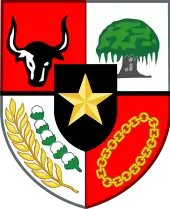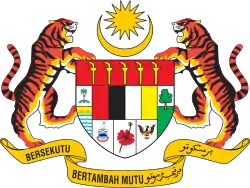Songket
Songket is a fabric that belongs to the brocade family of textiles of the Malay world (today, Brunei, Indonesia, Malaysia, Singapore and Southern Thailand). It is hand-woven in silk or cotton, and intricately patterned with gold or silver threads.[1] The metallic threads stand out against the background cloth to create a shimmering effect. In the weaving process the metallic threads are inserted in between the silk or cotton weft (latitudinal) threads in a technique called supplementary weft weaving technique.[2]
 A typical Minangkabau songket, the pattern in the lower third representing bamboo sprouts | |
| Type | Art Fabric |
|---|---|
| Material | silk, cotton, gold, silver |
| Place of origin | Brunei, Indonesia and Malaysia |
In Indonesia, five songket traditions are recognised as Intangible Cultural Heritage by the Indonesian Ministry of Education and Culture.[3] They are songket traditions of Palembang[4] and Sambas,[5] both appointed in 2013; Pandai Sikek songket of West Sumatra,[6] appointed in 2014; songket tradition of Beratan, Bali appointed in 2018;[7] and Silungkang songket tradition of West Sumatra, appointed in 2019.[8]
Etymology

The term songket comes from the Malay word sungkit, which means "to hook". It has something to do with the method of songket making; to hook and pick a group of threads, and then slip the gold and silver threads in it.[9] Another theory suggested that it was constructed from the combination of two terms; tusuk (prick) and cukit (pick) that combined as sukit, modified further as sungki and finally songket.[10] Some says that the word songket was derived from songka, a Palembang cap in which gold threads was first woven.[11]
The Malay word menyongket means ‘to embroider with gold or silver threads’.[12] Songket is a luxury product traditionally worn during ceremonial occasions as sarong, shoulder cloths or head ties and tanjak, a headdress songket. Songket were worn at the courts of Kingdoms in Sumatra especially the Srivijaya, as the source and the origin of Malay culture in Southeast Asia.[13] In the early kingdom age, Songkets are also traditionally worn as an apparel by the Malay royal families in Sumatra such as the Deli Sultanate in Medan, Serdang Sultanate, Palembang Sultanate in Palembang and the recently restored royal house in Jambi and the Malay Peninsular such as the Pattani Sultanate, Sultanate of Kelantan, Terengganu Sultanate.[14] Traditionally women are the weavers of songket, however in this modern time men also are known to weave it as well.[11]
Songket is known in many names in vernacular Indonesian languages. Other than in Sumatra and Malay peninsula, it is also commonly known as songket in Bali and Java. While it is known as songke in Manggarai, Flores, and Bima in Sumbawa. The Karo Batak of North Sumatra, call it jongkit. People in Ternate, Maluku, call it suje, while the Buginese in South Sulawesi call it subbi’ and arekare’ and the Iban Dayak in West Kalimantan and Sarawak call it pilih or pileh.[2]
History
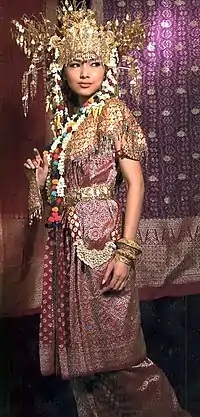
Songket weaving traditions at first, historically associated with Srivijaya empire,[15][16] a wealthy 7th to 13th-century maritime trading empire based on Sumatra. Palembang and Minangkabau Pandai Sikek area are the best and the most famous songket producers in Indonesia.
Based on archaeological data, it can be seen that songket has been known by the people of South Sumatra since the 9th century CE, as seen in ancient statues cloths motifs from the site of the Bumiayu temple complex in Penukal Abab Lematang Ilir Regency, South Sumatra Province, Indonesia.[17] It associated with areas of Malay settlement in Sumatra, and the production techniques could have been introduced by Indian or Arab merchants.[11]
Songket is a luxurious textile that required some amount of real gold leaves and gold threads to be hand-woven into exquisite fabrics. Historically the gold mines are located in Sumatra hinterland; Jambi and Minangkabau highlands. Although gold threads were found buried in the Srivijaya ruins in Sumatra, along with unpolished rubies and pieces of gold plate, there is no corroborating evidence that the local weavers used gold threads as early as 7th century to early 8th century.[11]
However, according to Kelantan tradition this weaving technique came from the north, somewhere in the Cambodia-Siam region and expanded south into Pattani, and finally reach the Malay court of Kelantan and Terengganu as early as the 16th century.[18][19] The weaving of songket continues as a small cottage industry on the outskirts of Kota Bharu and Terengganu.[20] However, Terengganu weavers believe that songket weaving technique was introduced to Malaysia from India through Sumatra's Palembang and Jambi where it probably originated during the time of Srivijaya (7th to 11th century).[11]
Much documentation is sketchy about the origins of the songket but it is most likely that songket weaving was brought to Peninsular Malaysia through intermarriages between royal families. This was a common occurrence in the 15th century for sealing strategic alliances. Production was located in politically significant kingdoms because of the high cost of materials; the gold thread used was originally wound with real gold leaf.[21]
Songket as king's dress was also mentioned by Abdullah bin Abdul Kadir writings in 1849.[22]
Tradition

Songket is traditionally considered an exquisite, luxurious and prestigious traditional fabric, only worn for special occasions, religious festivals, and traditional social functions. It has become a required garment for brides and grooms for their weddings, as in the traditional wedding costumes of Palembangese, Minangkabau and Balinese people.[23]
Today, songket is mostly worn in traditional settings as traditional costumes for weddings or any traditional ceremonies. Several efforts has been conducted to promote songket as a popular fabric for fashion, either locally and abroad. During the Dutch colonial era, West Sumatran songket were exhibited in the Netherlands. The Sawahlunto Songket Carnival was held in Sawahlunto, West Sumatra in August 2015. The songket carnival featured a parade and exhibition with participants from numbers of songket studios across West Sumatra. The carnival, held on 28 August 2015, was recorded in the Indonesian Museum of Records for the most people wearing songket at a same time, with 17,290 people wearing Silungkang songket during the event.[24]
Several exhibitions has been held to preserve and promote the traditional art of songket making, such as the songket exhibition held in 2015 by Jakarta Textile Museum, which showcased around 100 pieces of songket from various Indonesian provinces.[25]
Today, songket has become a source of inspiration for contemporary fashion designers who draw ideas from this traditional art.[26]
Songket making
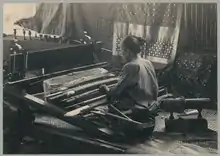

Equipments and materials
There are two categories of songket weaving equipments; the main weaving equipment made from wooden or bamboo frame; and the supporting equipment which includes thread stretching tool, motif making tool, thread inserting and picking tools. The materials for making songket consist of cotton or silk threads or other fibers as the base fabric and decoration threads made from golden, silver or silk threads. It is believed that in ancient times, real gold threads were used to create songket; the cotton threads were run along heated liquid gold, coating the cotton and creating gold thread. However today because the scarcity and the expensiveness of real gold threads, imitation gold or silver threads are commonly used instead.
Technique
The songket technique itself involves the insertion of decorative threads in between the wefts as they are woven into the warp, which is fixed to the loom. They are inserted as part of the weaving process, but not necessary in the making of the cloth. There are four types of supplementary weft weaving technique: continuous, discontinuous, inlaid and wrapped.[2]
Songket weaving is done in two stages, weaving the basic cloth with even or plain weaving and weaving the decoration inserted into basic cloth, this method is called "inlay weaving system".[10] The shining gold, silver or silk threads were inserted and woven into the plain weave base cloth in certain motifs, creating a shimmering effect of golden pattern against darker plain background. Songket weaving is traditionally done as a part-time job by young girls and older women in between their daily domestic chores. The complicated process of songket making is believed to cultivate virtues, as it reflects the values of diligence, carefulness and patience.
Patterns
There are hundreds of songket patterns. In Palembang tradition, songket is inseparable from the lives of the people who wear it during important events such as births, marriages, and death.[1] Examples of Palembang songket patterns are naga besaung, pucuk rebung, biji pare, bintang berante, bintang kayu apuy, bungo mawar, bungo melati, bungo cino, bungo jepang, bungo intan, bungo pacik, cantik manis, lepus berakam, pulir, nampan perak, tabur limar and tigo negeri.[10]
Production centers
In Indonesia, songket is produced in Sumatra, Kalimantan, Bali, Sulawesi, Lombok and Sumbawa. In Sumatra the famous songket production centers is in Minangkabau Pandai Sikek area,[27] and Koto Gadang in Agam Regency, also Silungkang area in Sawahlunto, West Sumatra,[24] Jambi City, Jambi and Palembang, South Sumatra. In Bali, songket production villages can be found in Klungkung regency, especially at Sidemen and Gelgel village.[28] The Klungkung Market is a popular spot to shop Balinese songket, as it offers wide collection of this traditional fabrics.[23]
While in the neighboring island of Lombok, the Sukarara village in Jonggat district, Central Lombok regency, is famous for songket making.[29] In this village, learning how to weave a good songket is an obligation for the Sasak women. Weaving songket is usually done by women during their spare time, and subsequently this traditional skill has enabled them to earn money for their family.[30]
Further production areas include the east coast of the Malay Peninsula[31] especially in Terengganu and Kelantan, and in Brunei.[21]
Gallery
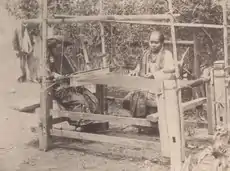 Songket weaver in West Sumatra, Dutch East Indies. Circa 1890
Songket weaver in West Sumatra, Dutch East Indies. Circa 1890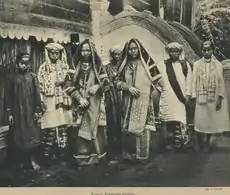 Minangkabau women in songket attire on Sumatra's west coast, Dutch East Indies. circa 1915
Minangkabau women in songket attire on Sumatra's west coast, Dutch East Indies. circa 1915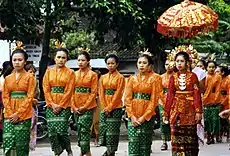 A Lombok wedding party using songket. On Lombok, most weddings are held during the month of April, and the parades are held on Sundays, West Nusa Tenggara
A Lombok wedding party using songket. On Lombok, most weddings are held during the month of April, and the parades are held on Sundays, West Nusa Tenggara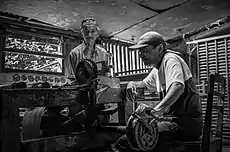 The stage of winding the weaving threads into a place where the spools of thread function as thread for the length of the songket cloth in Sumatra
The stage of winding the weaving threads into a place where the spools of thread function as thread for the length of the songket cloth in Sumatra Shoulder cloth. The entire length of the plaid silk is decorated with gold thread (songket). The edges were decorated with gallons and gold trim, the shoulder cloth was silk with gold thread trimmings in Sumatra, circa 1900 (Tropenmuseum)
Shoulder cloth. The entire length of the plaid silk is decorated with gold thread (songket). The edges were decorated with gallons and gold trim, the shoulder cloth was silk with gold thread trimmings in Sumatra, circa 1900 (Tropenmuseum)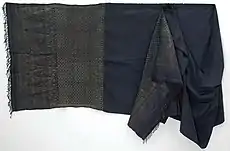 Selendang, Long silk scarf from Aceh, Sumatra. The ends are decorated with weft thread from the golden thread (songket) of the ceremonial shawl, circa 1900 (Tropenmuseum, Netherland)
Selendang, Long silk scarf from Aceh, Sumatra. The ends are decorated with weft thread from the golden thread (songket) of the ceremonial shawl, circa 1900 (Tropenmuseum, Netherland)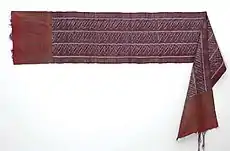 Chest cloth. Silk breast cloth is decorated with a tie in the weft and additional weft of gold thread (songket). This cloth decorated with gold threads is mainly used on celebratory occasions, the silk breast cloth with a motif is applied to weft in Sumatra, circa 1900 (Tropenmuseum, Netherland)
Chest cloth. Silk breast cloth is decorated with a tie in the weft and additional weft of gold thread (songket). This cloth decorated with gold threads is mainly used on celebratory occasions, the silk breast cloth with a motif is applied to weft in Sumatra, circa 1900 (Tropenmuseum, Netherland) Fabric. Silk clothes for women decorated with additional weft motif from gold thread (songket). Silk cloth for women in Sumatra, circa 1900 (Tropenmuseum, Netherland)
Fabric. Silk clothes for women decorated with additional weft motif from gold thread (songket). Silk cloth for women in Sumatra, circa 1900 (Tropenmuseum, Netherland)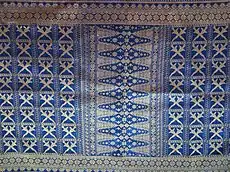 Songket fabric with keris motif with a bamboo shoot in the middle from West Sumatra, Pucuak rabuang is one of the Minangkabau traditional motifs
Songket fabric with keris motif with a bamboo shoot in the middle from West Sumatra, Pucuak rabuang is one of the Minangkabau traditional motifs Minangkabau typical traditional songket weave, West Sumatra
Minangkabau typical traditional songket weave, West Sumatra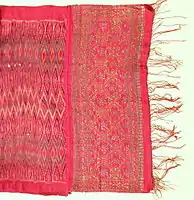 Songket Endek, a Singaraja silk Endek selendang. Early20th cent. a collection of Balique Arts of Indonesia
Songket Endek, a Singaraja silk Endek selendang. Early20th cent. a collection of Balique Arts of Indonesia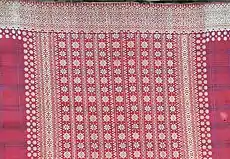
References
- Dina Indrasafitri (May 19, 2010). "Glimmering 'songket' aims at spotlight". The Jakarta Post. Jakarta. Archived from the original on December 17, 2013. Retrieved December 17, 2013.
- Niken Prathivi (2 August 2015). "New book looks into 'songket' & weaving traditions". The Jakarta Post. Jakarta. Retrieved 26 October 2015.
- "Warisan Budaya Takbenda, Penetapan". Cultural Heritage, Ministry of Education and Culture of Indonesia. Retrieved 14 December 2020.
- "Songket Palembang". Cultural Heritage, Ministry of Education and Culture of Indonesia. Retrieved 14 December 2020.
- "Songket Sambas". Cultural Heritage, Ministry of Education and Culture of Indonesia. Retrieved 2020-12-14.
- "Songket Pandai Sikek". Cultural Heritage, Ministry of Education and Culture of Indonesia. Retrieved 14 December 2020.
- "Songket Beratan". Cultural Heritage, Ministry of Education and Culture of Indonesia. Retrieved 14 December 2020.
- "Songket Silungkang". Cultural Heritage, Ministry of Education and Culture of Indonesia. Retrieved 14 December 2020.
- Diaz, Anton (2009). "Songket Palembang, Busana dan Aksesori Nusantara". National Geographic Traveller Indonesia (in Indonesian). 1 (6). Jakarta, Indonesia. p. 63.
- "Songket Weaving of Palembang, South Sumatra". Melayu Online. Retrieved December 17, 2013.
- Rogers, Susan; Summerfield, Anne; Summerfield, John (2007). Gold Cloths of Sumatra: Indonesia's Songkets from Ceremony to Commodity. Worcester, Massachusetts: Cantor Art Callery. ISBN 978-9067183123. Retrieved 15 January 2012.
- "Menyongket" (in Malay). Dewan Bahasa dan Pustaka (DBP). Retrieved 4 March 2018.
- "The Art of Songket". puratanjungsabtu.com. Archived from the original on 26 January 2008. Retrieved 9 April 2018.
- "Sentuhan songket diraja". Utusan Online. Retrieved 9 April 2018.
- "The Ancient Sriwijaya Heritage" Featuring Glimpse of Songket in Traditional Southern Sumatra Wedding Ceremony
- Sriwijaya Post. "Motif Abstrak Songket palembang" (in Indonesian). Sriwijaya Post. Retrieved 2012-01-16.
- Ministry of Education and Culture of Indonesia. "SEJARAH SONGKET BERDASARKAN DATA ARKEOLOGI" (in Indonesian). Ministry of Education and Culture of Indonesia. Retrieved 2021-01-26.
- Rodgers, Susan; Summerfield, Anne; Summerfield, John (9 April 2018). Gold Cloths of Sumatra: Indonesia's Songkets from Ceremony to Commodity. KITLV Press. ISBN 9789067183123. Retrieved 9 April 2018 – via Google Books.
- Selvanayagam, Grace Inpam (9 April 1990). Songket: Malaysia's Woven Treasure. Oxford University Press. ISBN 9780195889284. Retrieved 9 April 2018 – via Google Books.
- Bloom, Jonathan M.; Blair, Sheila S. (9 April 2018). The Grove Encyclopedia of Islamic Art and Architecture. Oxford University Press. ISBN 9780195309911. Retrieved 9 April 2018 – via Google Books.
- Uchino, Megumi (July 2005). "Socio-cultural history of Palembang Songket". Indonesia and the Malay World. Routledge. 33 (96): 205–223. doi:10.1080/13639810500283985. S2CID 143749412.
- Hamdani, Hamzah (9 April 2018). Hikayat Abdullah. PTS Pop. ISBN 9789831920800. Retrieved 9 April 2018 – via Google Books.
- I Wayan Juniarta (28 January 2016). "Sojourn: Klungkung market – 'A go-to place for cloth lovers'". The Jakarta Post.
- Syofiardi Bachyul Jb (31 August 2015). "Govt urged to promote 'songket' after success with batik". The Jakarta Post.
- "Jakarta Textile Museum hosts songket exhibition". The Jakarta Post. Jakarta. 19 August 2015.
- Tertiani ZB Simanjuntak (27 August 2016). "Fashion Flair: Reinventing Indonesian fabrics for today". The Jakarta Post.
- "Tenun Songket Pandai Sikek (Sumatera Barat - Indonesia) - Melayu Online". melayuonline.com (in Indonesian). Retrieved 9 April 2018.
- Suardana, Kartika (2009). "Songket Bali, Busana dan Aksesori Nusantara". National Geographic Traveller Indonesia (in Indonesian). 1 (6). Jakarta, Indonesia. p. 62.
- Ukirsari, Manggalani L. (2009). "Songket Lombok, Busana dan Aksesori Nusantara". National Geographic Traveller Indonesia (in Indonesian). 1 (6). Jakarta, Indonesia. p. 62.
- Afrida, Nani (22 April 2013). "Women, weaving and delopement in Lombok". The Jakarta Post. Retrieved 31 October 2016.
- Mohamad, Maznah (9 April 1996). The Malay Handloom Weavers: A Study of the Rise and Decline of Traditional Manufacture. Institute of Southeast Asian Studies. ISBN 9789813016996. Retrieved 9 April 2018 – via Google Books.
Further reading
- Achjadi, Judi (2015). Floating Threads: Indonesian Songket and Similar Weaving Traditions. Jakarta: BAB Publishing Indonesia. ISBN 978-6027208506.
- Rodgers Susan; Anne Summerfield; John Summerfield (2007). Gold Cloths of Sumatra: Indonesia's Songkets from Ceremony to Commodity. Leiden: KITLV Press. ISBN 978-9067183123.
- Summerfield, Anne; John Summerfield (1999). Walk in Splendor: Ceremonial Dress and the Minangkabau. UCLA. ISBN 0-930741-73-0.
- Smith, Holly S. (1997). Aceh Art and Culture. Kuala Lumpur: Oxford University Press.
External links
| Wikimedia Commons has media related to Songket. |
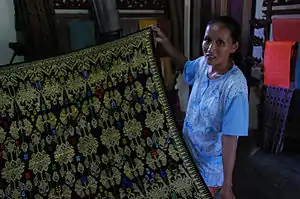
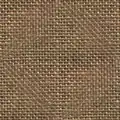
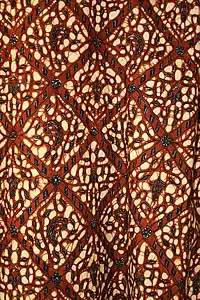
.svg.png.webp)
